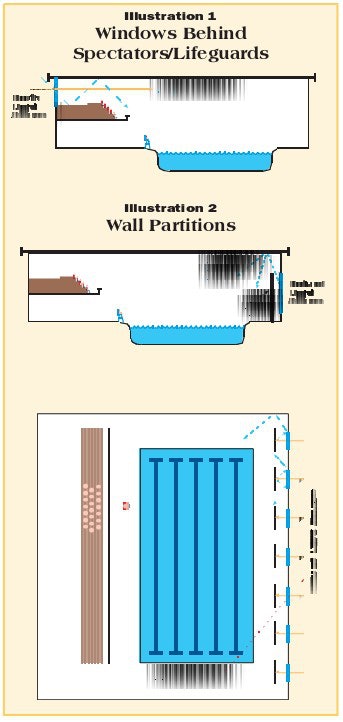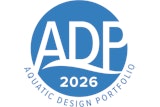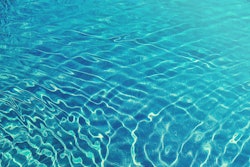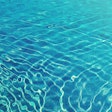Proper design and placement of natural and artificial light sources can ensure people see your natatorium in the best possible light

Lighting indoor swimming spaces has never been the easiest part of natatorium design - although frequently, and with regrettable results, it has been treated that way. With today's multipurpose aquatic centers frequently accommodating diverse programming activities in a shared environment, it has become an even greater creative challenge to get the light right. But with proper foresight - including careful consideration of the planned uses of the facility - aquatic facility designers can avoid the glaring mistakes of the past and make certain people see natatoriums in the best light possible.
Natural light is an increasingly attractive option for indoor aquatic facilities. Large windows or open fenestration can be energy-efficient ways to supplement artificial heat and lighting, and they add visual interest for users and a much-appreciated connection to the outside for employees who work all day in an enclosed environment. With all its advantages, however, natural light can be accompanied by an undesirable partner - glare. Both an aesthetics problem and a significant safety issue, glare from poorly positioned window openings can turn competitive swimmers into unidentifiable, anonymous silhouettes in front of coaches, spectators and television cameras. Severe glare can make it difficult or even impossible for officials to see beneath the surface to judge strokes, turns, starts and finishes (this was a problem at the 1956 Olympics venue in Melbourne, Australia). Far more seriously, recreational swimmers beneath the impenetrable screen of a mirrored water surface can disappear altogether from lifeguards' view.
Reflections occur when light rays hit a surface and bounce off. The angle at which the ray hits the surface is equal to the angle at which it bounces off. This angle is known as Brewster's angle, and represents the point of maximum reflectance off the surface of the object. We perceive the glare because of the highly reflective nature of water and the sharp contrast between the light from the windows or artificial light source and the relative darkness of the surrounding walls, ceilings and floors.
The worst-case glare problems occur when viewers - spectators, lifeguards or coaches - are positioned opposite windows, wall openings or artificial lighting, with the pool in between. The light bouncing off the water surface causes viewers to squint and strain to make out the silhouetted objects moving through the silver reflections on the water.
Glare doesn't just occur, however, when the light source is opposite the viewer. Contrasting elements of light and dark can shed unwanted reflections on the water's surface any time the light source is within the field of vision of the viewer.
Solving glare problems is frequently simple. If light can be provided without the viewer experiencing light and dark contrasts in his or her field of vision, the most objectionable glare will be eliminated. The most common architectural solution in constructing new competitive venues is to place the windows or other fenestration behind the spectator stands so light washes over the ceiling to the far wall and down to the pool deck. By positioning the light source behind the viewers, out of their line of vision, intense reflections and glare problems are avoided.
This is all well and good for new facilities, but what about existing natatoria? Must they brick up their old windows and blast new holes in the walls to resolve glare problems. Not at all. With some creative coverups, almost any glare problem can be significantly reduced and even eliminated.
Windows and open fenestration on opposite walls can be controlled by constructing opaque walls, partitions, facades, soffits or baffles to block the direct light, allowing indirect, deflected light to bounce off the structure and spill into the natatorium space. In designing these features, careful consideration should be given to wall coloring, using combinations of light and dark surface areas to maximize the effectiveness of the indirect natural light.
Glare caused by end-wall lighting is not as severe as that created by opposite wall lighting, but it can be a problem, particularly for competitive swimmers performing the breaststroke, backstroke or butterfly. An attractive solution to endwall lighting problems is a wall design using saw-tooth panels to direct light away from the water.
Skylights are usually not problematic, since the angle of reflection from an overhead source is normally not great enough to be an issue. If glare compromises the view from high spectator seating, however, a recessed clerestory can be installed to achieve toplighting with the same indirect benefits as achieved with baffles.
If large, open windows are preferred for the majority of the facility's programming, movable shades, shutters or blinds can be an attractive alternative to permanent baffles. These features allow direct natural light to brighten up the natatorium during periods of daytime recreational swimming, while providing the flexibility to shut out that light and any resulting glare during competitive events.
No natatorium is a natural beauty. In fact, many indoor aquatic facilities are completely illuminated by artificial lighting, and all require some kind of supplemental lighting for nighttime and special-event programming. The proper choice and placement of artificial lights will help lower maintenance and utility costs, and can both add to the atmosphere of the facility and reduce or eliminate glare problems caused by natural light.
While glare can be a problem with powerful, improperly placed artificial lights, a more frequent concern is shadows cast onto and beneath the water surface. Light fixtures suspended from the ceiling over the deck are easier to relamp, but frequently cast dark shadows from the pool edge that darken the walls of the pool shell. Improperly placed overhead lights can also cast distracting shadows from obstructing ductwork, structural beams and other objects.
The preferred positioning, then, for overhead lighting in a competitive pool environment is directly above the water surface. This is particularly important for pools without underwater lighting. Light deteriorates in water at a rate of 50 percent in the first foot; at a depth of 6 to 7 feet, the level of illumination has dropped to as little as 10 percent of its intensity at the water's surface. Casting light straight down penetrates the deep water most efficiently and creates a minimum of shadows. At greater angles, more light is reflected off the water surface, casting bigger shadows from the pool edge and causing the bottom of the pool to appear darker.
Of course, lights placed over the water surface can present a maintenance headache, since they can't be accessed easily from a deck ladder or lift. This problem can be addressed by mounting the lights on catwalks or providing access above the ceiling. Another maintenance and liability headache - the potential for broken glass from an exploded bulb to fall into the pool or onto the pool deck - is solved by providing a lens covering on all fixtures. This creates a more evenly distributed light and looks nicer, and also provides a barrier between the lamp and the pool should the bulb break.
Underwater lights, required by code in some jurisdictions, are helpful in brightening up the deep waters of a competitive pool - but they can do much more than illuminate the water. Underwater lights can reduce and even eliminate some moderate to severe glare problems. If the physics behind this are difficult to see, consider what a glass-front office building looks like at night. When the lights are off inside the building, windows reflect the city lights and structures nearby. But in those offices where the lights are on, the reflections disappear, allowing us to see who's working the night shift.
The same principle allows pool designers to "bleach" out surface reflection by countering it with underwater lighting, although glare can't be completely eliminated in this manner. Glare reduction is dependent upon the intensity of the light above the water and the relative strength of the underwater lights.
In contemporary free-form leisure pools, water is generally much shallower - usually from zero to 3 1/2 feet. The light placement issue in leisure pool environments is therefore not penetration of deep water, but rather the creation of a mood. Thus, underwater lighting in leisure pools is frequently tinted or positioned to add character to the otherwise flat characteristics of the water.
Hand in hand with the issue of placement is the light intensity required for various programming needs. Competitive events will generally require a much greater intensity of light than recreational or lesson programming. Among their rules and regulations, governing bodies of various competitive organizations usually include precise specifications for venue standards, including lighting requirements. One hundred footcandle (107 lux) illumination is required at the water surface for U.S. Swimming and collegiate championship events. For World Championships and Olympic Games, FINA rules stipulate 500 lux illumination.
Obviously, to maintain these light levels at all times would be a needless utilities expense and an undesirable environment for nighttime recreation programming and other non-competitive events. Consequently, lighting is frequently designed to perform a variety of functions. A flexible lighting system might provide both indirect and direct lighting to be chosen alternatively or in combination according to event requirements.
Lighting competitive events for television coverage is a significant challenge, according to Steve Uline, director of Bud Sports, a television production company that has covered national and international sports competitions for more than 15 years. The company's typical lighting arrangement for indoor aquatic events includes "quartz vapor lighting the full length of the pool on both sides, so we can shoot 360 degrees without any shadows," Uline says. "We block all windows and place our own lights high enough so we don't have glare problems." The good news for facility owners planning to host such events is that most television crews will have their own requirements and will therefore be prepared to provide their own portable lighting to cover specific needs.
In leisure environments, opportunities exist for much more flexibility and creativity in lighting design. Light intensity at the water and deck surface is typically much more muted, usually in the range of 20 to 50 foot-candles, and frequently consists of a variety of spotlights, indirect lights and underwater lighting in color ranges that provide more interest and excitement to the interior environment. However, with the need for safety still paramount, family aquatic center managers must keep on the lookout for "hot spots" and "blind spots" that these lights can cause.
The final decision to make when lighting an indoor aquatic space is the type of light source to specify. In leisure settings, lighting choices may run the gamut from incandescent to fluorescent, halogen and any of the high-intensity lighting choices. For competition pools, however, high intensity discharge (HID) lamps are the preferred choice.
There are several types of HID lamps, all of which operate on the same principle (light is produced from gas or vapor inside an electrically charged arc tube). All are relatively long-lived compared to other lamp choices, making them preferable for difficult-to-access locations. But each has other advantages and disadvantages that should be considered during the selection process.
Mercury vapor lamps, the first HID lamps produced, feature low initial cost and a long lifetime, and produce a white light that they retain well over time. While more efficient and cost-effective lamps have since been developed, mercury vapor lamps remain an option for locations where lamp replacement is difficult.
Metal halide lamps have a very high light output and are considerably more efficient than mercury vapor lights. The quality of the light is also typically very good, usually a clean white light that delivers good color accuracy. Among their most significant disadvantages are the long cool-down and warm-up time required between start-ups. Metal halide lamps also must be shielded against UV radiation emission and their color accuracy can shift over time. Despite those drawbacks, the light quality and efficiency of metal halide lamps continue to make them a preferred choice in many applications.
High-pressure sodium lamps are also highly efficient and long-lived, some lasting in the range of 10,000 to 40,000 hours. The conventional sodium lamp, however, produces a very warm, golden light that may not be desirable in some applications. Newer versions are being produced that create a whiter light, but these are not as efficient as conventional high-pressure lamps.
Pool lighting options are numerous, and programming requirements, utility and maintenance considerations, local codes and user-group stipulations all have to be taken into account when deciding the positioning and type of lighting components in a natatorium. A challenging job when the facility is designed for a single category of users, it's an even greater challenge when the mix becomes more broad-based, as is usually the case with today's multipurpose facilities. And if there's one place you don't want to skimp, it's in the lighting systems. It's not that lighting system shortcuts will adversely affect the entire facility. They'll just cast a bad light on everything the public sees.




































